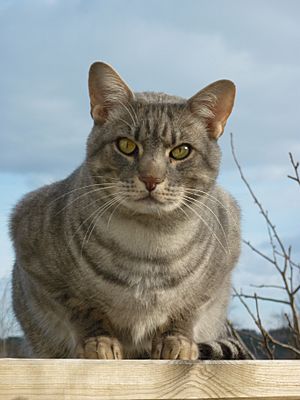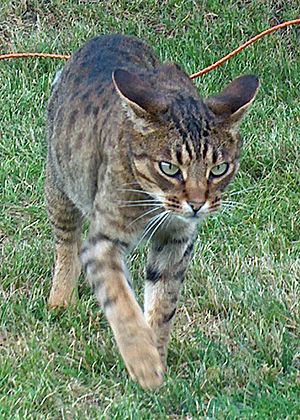Ocicat facts for kids
Quick facts for kids Ocicat |
|
|---|---|
 |
|
| Origin | United States |
| Breed standards | |
| CFA | standard |
| FIFe | standard |
| TICA | standard |
| AACE | standard |
| ACFA/CAA | standard |
| CCA-AFC | standard |
| Notes | |
|
Slightly larger than regular domestic cats.
|
|
| Domestic cat (Felis catus) | |
The Ocicat is a special type of cat. It looks a lot like a wild cat, with its cool spots, but it's actually a friendly domestic pet! It doesn't have any wild cat DNA in its family tree. The name "Ocicat" comes from the ocelot, a wild cat it resembles.
This breed started by accident when Siamese cats and Abyssinian cats were bred together. Later, American Shorthair cats were added to give them more colors, like silver, and a strong body. Today, Ocicats are loved by many people around the world.
Contents
What Ocicats Look Like
Ocicats come in many different fur colors. There are twelve main colors accepted for the breed. These include tawny, chocolate, cinnamon, blue, lavender, and fawn.
They also come in "silver" versions of these colors. For example, you can find black silver (also called ebony silver), chocolate silver, and blue silver.
Ocicats have eyes shaped like almonds. Their bodies are large and strong, and their legs have dark markings. Their paws are oval-shaped. The fur around their eyes is usually dark. All Ocicats have dark spots on their fur that stand out from their background color. Their strong, muscled bodies make them look powerful.
How Ocicats Behave
Most Ocicats are very friendly and brave. This makes them great family pets. They usually get along well with other animals too.
Their actions and moods are often like those of a dog. Many Ocicats can learn to fetch toys, walk on a leash, and come when you call them. Some even enjoy playing in water! They are very playful and love toys. Because of this, Ocicats need a lot of attention from their owners.
The History of the Ocicat
The first Ocicat was born by accident in 1964. A breeder named Virginia Daly, from Michigan, was trying to create a Siamese cat with Abyssinian markings.
One of her kittens, named Tonga, had spots! Virginia's daughter thought Tonga looked like an 'ocelot' and called him an 'ocicat'. Tonga was sold as a pet, but his parents had more spotted kittens. This was the beginning of the Ocicat breed.
Other breeders then started to do the same thing. They bred Siamese cats with Abyssinians, and then bred those kittens with Siamese cats to get more Ocicat kittens. The Ocicat breed was officially recognized by The Cat Fanciers' Association and first competed in cat shows in 1987.
Images for kids
See also
 In Spanish: Ocicat para niños
In Spanish: Ocicat para niños








